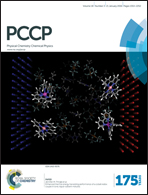Characterizing the nanoclay induced constrained amorphous region in model segmented polyurethane–urea/clay nanocomposites and its implications on gas barrier properties
Abstract
There has been an increasing recognition of the fact that purely geometric factors associated with clay platelet dispersion in a polymer matrix cannot adequately explain the barrier properties of polymer/clay nanocomposites. The objective of the present work is to understand the nanoclay induced structural changes in a polyurethane–urea matrix and clay dispersion at different length scales using segment-specific characterization techniques and implications of the same in gas barrier properties using He, N2 and CO2 as probe molecules. Wide angle X-ray diffraction (WAXD) and positron annihilation life time spectroscopy (PALS) studies revealed nanoclay induced alterations in the chain packing of the amorphous soft segments of the polyurethane matrix at a molecular scale of a few Angstroms. The hard segment organization and the phase morphology of the nanocomposites, spanning length scales of several nanometers, were investigated by small angle X-ray scattering (SAXS), scanning electron microscopy (SEM) and atomic force microscopy (AFM). Furthermore, the presence of a constrained amorphous region surrounding the nanoclay was confirmed from AFM, WAXD and PALS results. Several pertinent structural variables from the gas transport point of view were deduced from these characterization techniques to understand the effect of the barrier properties in tandem with the clay dispersion morphology.


 Please wait while we load your content...
Please wait while we load your content...